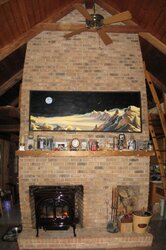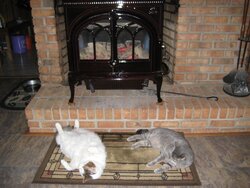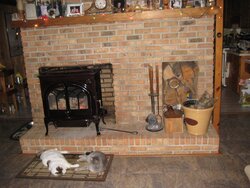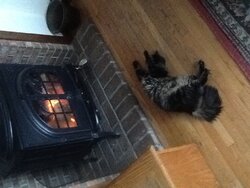Last edited by a moderator:
Life is Good!
- Thread starter Nick Mystic
- Start date
-
Active since 1995, Hearth.com is THE place on the internet for free information and advice about wood stoves, pellet stoves and other energy saving equipment.
We strive to provide opinions, articles, discussions and history related to Hearth Products and in a more general sense, energy issues.
We promote the EFFICIENT, RESPONSIBLE, CLEAN and SAFE use of all fuels, whether renewable or fossil.
You are using an out of date browser. It may not display this or other websites correctly.
You should upgrade or use an alternative browser.
You should upgrade or use an alternative browser.
- Status
- Not open for further replies.
Diabel
Minister of Fire
That glass is soooo clean! Is the air wash this good or you clean it everyday?
If you would not mention the word "cat" I would have thought these are walruses stove bathing!!
Sorry I thought it....had to say it!!
If you would not mention the word "cat" I would have thought these are walruses stove bathing!!
Sorry I thought it....had to say it!!
Mackj
Member
Beautiful stove! I have been looking hard at a lot of stoves and am very close to buying one too. I plan on removing Lennox insert this summer. Will demo corner install and build new hearth.
Kevin Dolan
Burning Hunk
Nick how long can you get that stove to burn with a full load?34 F outside with rain and sleet. 72 F inside with a nice glow from the stove. You can't ask for much more than that except maybe to be a cat!
View attachment 151525
View attachment 151526
The air wash system on the F 600 is pretty good. I like to keep the glass clean because I watch the fire every night for about an hour or so after the last reload before I turn in. I put some smooth jazz or ambient music on my Internet radio and chill out in front of the fire. About once a week I'll use some vinegar/water solution I keep in a spray bottle and a paper towel to wipe the haze off the glass. For the first couple of days it will stay very clear, but then I'll start to notice this light haze forming. Once in a while I'll have to reach in before a reload in the morning and brush off a bit of ash that splashed up on the glass from a log shifting or falling during a burn.
I mostly burn oak that's been seasoning for three years under cover. With about a 3/4 full load I'll let the wood get fully engulfed with the primary air wide open. Then I'll shut it down to about 1/2 at 300 F. Just a few minutes later I'll shut it down to 1/8 and if the secondaries are firing off strong I'll close it down all the way. At that point I'm running around 450 F. The stove will burn a couple of hours at this level before starting to lose the secondaries with the temperature dropping to between 350 F - 400 F. If it is during the day and I'm monitoring the fire I'll then start opening the air back up to keep the temperature up. When all the flames are gone I'll open the air back full open for the last hour or so to finish burning off the coals. From reload to reload I'm looking at about 5 1/2 hours with the stove running around 300 F at the end of the cycle. Overnight I do my last reload around 10 p.m. and at 7:30 a.m. I will have enough hot coals in the stove to reload with very little kindling, if any, needed. If I'm burning a softer wood like pine or poplar the cycle runs about an hour or an hour and a half shorter.
I mostly burn oak that's been seasoning for three years under cover. With about a 3/4 full load I'll let the wood get fully engulfed with the primary air wide open. Then I'll shut it down to about 1/2 at 300 F. Just a few minutes later I'll shut it down to 1/8 and if the secondaries are firing off strong I'll close it down all the way. At that point I'm running around 450 F. The stove will burn a couple of hours at this level before starting to lose the secondaries with the temperature dropping to between 350 F - 400 F. If it is during the day and I'm monitoring the fire I'll then start opening the air back up to keep the temperature up. When all the flames are gone I'll open the air back full open for the last hour or so to finish burning off the coals. From reload to reload I'm looking at about 5 1/2 hours with the stove running around 300 F at the end of the cycle. Overnight I do my last reload around 10 p.m. and at 7:30 a.m. I will have enough hot coals in the stove to reload with very little kindling, if any, needed. If I'm burning a softer wood like pine or poplar the cycle runs about an hour or an hour and a half shorter.
Kevin Dolan
Burning Hunk
Thanks nick for your description of how you operate your primary air to keep temps where you want them, that is very helpful to me. With the f400 I don't get the same lenght of burns and I am not using oak although I have some that is three years stacked, split and dry so may try on an overnight burn. How has your winter been in NC so far?The air wash system on the F 600 is pretty good. I like to keep the glass clean because I watch the fire every night for about an hour or so after the last reload before I turn in. I put some smooth jazz or ambient music on my Internet radio and chill out in front of the fire. About once a week I'll use some vinegar/water solution I keep in a spray bottle and a paper towel to wipe the haze off the glass. For the first couple of days it will stay very clear, but then I'll start to notice this light haze forming. Once in a while I'll have to reach in before a reload in the morning and brush off a bit of ash that splashed up on the glass from a log shifting or falling during a burn.
I mostly burn oak that's been seasoning for three years under cover. With about a 3/4 full load I'll let the wood get fully engulfed with the primary air wide open. Then I'll shut it down to about 1/2 at 300 F. Just a few minutes later I'll shut it down to 1/8 and if the secondaries are firing off strong I'll close it down all the way. At that point I'm running around 450 F. The stove will burn a couple of hours at this level before starting to lose the secondaries with the temperature dropping to between 350 F - 400 F. If it is during the day and I'm monitoring the fire I'll then start opening the air back up to keep the temperature up. When all the flames are gone I'll open the air back full open for the last hour or so to finish burning off the coals. From reload to reload I'm looking at about 5 1/2 hours with the stove running around 300 F at the end of the cycle. Overnight I do my last reload around 10 p.m. and at 7:30 a.m. I will have enough hot coals in the stove to reload with very little kindling, if any, needed. If I'm burning a softer wood like pine or poplar the cycle runs about an hour or an hour and a half shorter.
We've had a mixed bag of weather this winter here in western NC. No snow so far, but on a few occasions we had very cold weather with daytime highs only in the 20s and night time lows in the single digits or teens. Such weather generally only lasts a few days before we warm back up to more seasonable temperatures, which for right now would be highs around 47 and lows around 27. Last week we went through our January thaw with temps up in the 60s for a few days. Where we live our elevation is around 1100 ft. I've burned through around 2 1/2 cords of wood so far.
countybrown
Member
The air wash system on the F 600 is pretty good. I like to keep the glass clean because I watch the fire every night for about an hour or so after the last reload before I turn in. I put some smooth jazz or ambient music on my Internet radio and chill out in front of the fire. About once a week I'll use some vinegar/water solution I keep in a spray bottle and a paper towel to wipe the haze off the glass. For the first couple of days it will stay very clear, but then I'll start to notice this light haze forming. Once in a while I'll have to reach in before a reload in the morning and brush off a bit of ash that splashed up on the glass from a log shifting or falling during a burn.
Glass top stove cleaner works REALLY good too. I had some under the sink yet from my old glass top range before I went to gas. Just another option for you and everybody else out there.
Swedishchef
Minister of Fire
NHcpa
Minister of Fire
Diabel
Minister of Fire
This morning in front of the Jotul...
View attachment 151564
I see one cat napping and one working hard.!
Are you meeting the front clearance with that gorgues unit?
I keep the front doors of the stove locked and do all my loading through the right side door where I have six feet of brick hearth. I keep a hearth rug in front of the stove for ember protection if a hot coal were to somehow roll off the hearth.
Diabel
Minister of Fire
I was referring to NHcpa
Nick, are your front doors locked permanently?
I believe there are manufacturers special door locks that can be installed for the stove to pass clearences.
Nick, are your front doors locked permanently?
I believe there are manufacturers special door locks that can be installed for the stove to pass clearences.
No, just the removable handle used to open and close the front doors. I keep it away from the stove so nobody can open the stove without the special tool.
Diabel
Minister of Fire
Yeah,
I don't think your nor NHcpa's set up would pass our local WETT inspection. I remember when I was installing my unit, I had a city WETT inspector here together with insurance inspector poking around for good two hours. Drove me crazy....
I don't think your nor NHcpa's set up would pass our local WETT inspection. I remember when I was installing my unit, I had a city WETT inspector here together with insurance inspector poking around for good two hours. Drove me crazy....
I'm sure you're correct. The regulations are pretty lax where I live. Our house had an insert installed slammer style when we bought the place about ten years ago. The insurance company never said anything about it when I got my coverage. I replaced the insert with the Jotul F 600 two years ago.
Diabel
Minister of Fire
Regardless, you have a beautiful set up. I love your stove!!
Question:
What is your square footage of the area you are heating? My stove sits in a approx 650sq ft room and if I was running it between 300 and 450 *F I would freeze!!
I need to push mine to the upper limit of 650-700 regularly to be comfortable. When it gets real cold I reload at 400.
Could be that your stove has more mass to rediate more heat at 400 than mine.
Not sure.
Question:
What is your square footage of the area you are heating? My stove sits in a approx 650sq ft room and if I was running it between 300 and 450 *F I would freeze!!
I need to push mine to the upper limit of 650-700 regularly to be comfortable. When it gets real cold I reload at 400.
Could be that your stove has more mass to rediate more heat at 400 than mine.
Not sure.
I'm sure you're correct. The regulations are pretty lax where I live. Our house had an insert installed slammer style when we bought the place about ten years ago. The insurance company never said anything about it when I got my coverage. I replaced the insert with the Jotul F 600 two years ago.
Slammers may have been dangerous, but they were legitimate and permitted when installed. For new installs, your locality may not inspect or enforce any clearance requirements, but if you ever had a fire and the insurance company said inadequate clearance was responsible, they might refuse to pay out.
TE
NHcpa
Minister of Fire
It's a top loader and requires a separate removable tool to open for ash and lighting. A pad would be necessary for embers, but once lit, doors do not open.
Diabel
Minister of Fire
I hear what you are saying. But it still does not change the fact that you need at least 19" of clearences in front.
I love both of your hearth looks and I love Jotul stoves. But when I notice something like this I feel obligated to mention it. Sorry.
I love both of your hearth looks and I love Jotul stoves. But when I notice something like this I feel obligated to mention it. Sorry.
NHcpa
Minister of Fire
My upstairs where the Jotul is located is around 1800 sq. ft. when you include the sleeping loft over the kitchen. Downstairs I heat another 1100 sq. ft. with a Woodstock Classic when I'm spending time down there in my man cave. Part of the reason I can run the stove at the temperature I do is because of the thermal mass provided by my fireplace/chimney which measures 8' x 4' x 20' tall. When I shoot it with my IR thermometer in the morning the bricks above the stove area are still reading about 125 F.

It should also be noted that when the Jotul is reading 400 F on one of the top corners (where the manual says to take readings) it's running over 600 F in the center of the top.

It should also be noted that when the Jotul is reading 400 F on one of the top corners (where the manual says to take readings) it's running over 600 F in the center of the top.
Swedishchef
Minister of Fire
I love that setup. It must cost a fortune to build a hearth like that with today's prices.
Andrew
Andrew
This home was built as the dream retirement home of a man about 20 years ago. It was a labor of love that he planned to live out his life in, but soon after completion he developed some serious heart problems and wasn't able to remain out in the country where an ambulance would have trouble reaching in an emergency, which forced him to sell it. Fortunately, he later had some heart surgery (after my wife and I purchased the house ten years ago) and has been able to make several visits back to his previous home to see the improvements I've made over the years. He told me on one of those visits that the fireplace/chimney (which continues downstairs another level) contains 6675 bricks! The chimney has three flues in it - one for the main fireplace upstairs, another where the Woodstock Classic is installed, and the third has an antique cooking stove hooked to it in the downstairs kitchen. I've never used that stove, so I can't comment on how it burns.
Diabel
Minister of Fire
- Status
- Not open for further replies.
Similar threads
- Replies
- 17
- Views
- 596
- Replies
- 16
- Views
- 1K
- Replies
- 11
- Views
- 954
- Replies
- 1
- Views
- 1K
- Replies
- 44
- Views
- 2K




